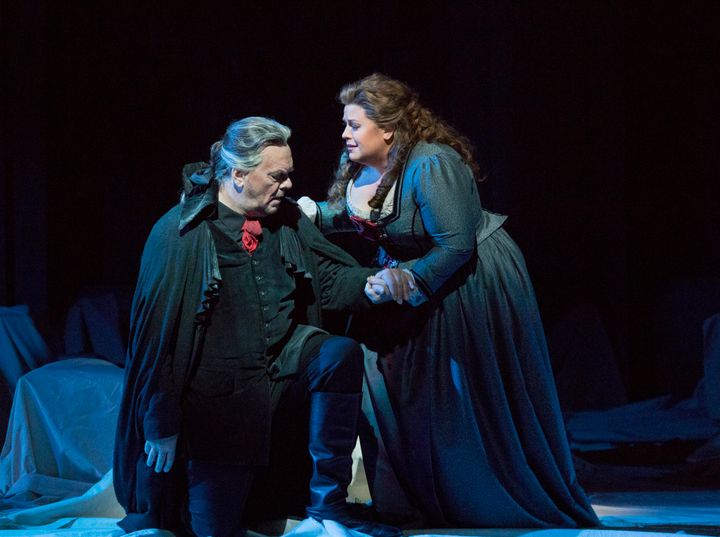
Michael Volle as the Dutchman and Amber Wagner as Senta in the Met’s Der Fliegende Hollander.
Doom doesn’t get much more captivating than in Der Fliegende Hollander, and with a splendid Amber Wagner and Michael Volle singing the ill-fated couple at the heart of Wagner’s haunting saga on the redeeming power of love, the Met Opera’s vintage production comes vividly to life.
Volle, a German baritone in only his third Met appearance, delivers a strong and moving performance in the title role of the Dutchman destined to sail the seas for eternity until he finds a wife who will remain faithful and free him. Volle has a rich, sonorous baritone that is alternately foreboding, hopeful, and ominous, a rich and mournful voice of doom.
As Senta, the sea captain’s daughter determined to save the Dutchman from his perpetual wandering, Wagner is superb. The Santa Barbara soprano is a natural Wagnerian with a powerful voice that rockets over the orchestra and soars into the upper register with an ease that is astonishing. This, too, is her third outing at the Met and one can only hope she returns soon and often.
The German bass Franz-Josef Selig adds an admirably avaricious Daland, Senta’s father, and AJ Glueckert, a young tenor from Oregon, makes a fine Met debut as Erik, Senta’s jealous suitor, in an all-round fine cast.
And the excellent Met Orchestra, under the animated baton of Yannick Nezet-Seguin, the Canadian conductor who has been named the next Met Music Director starting in 2020, provides much of the excitement for this revival of Der Fliegende Hollander, or popularly known as The Flying Dutchman.
From the crashing first chords of the Overture, Nezet-Seguin gave the orchestra full rein for a fortissimo reading of the score, and the orchestra, especially the brass, responded with alacrity. From stormy seas to sewing-circle chatter to eerie phantom sailors to pensive meditations on love and death, the music from the pit was magnificent. And at the curtain calls, the musicians showed their approval by showering Nezet-Seguin with a barrage of flowers tossed from the pit to the stage.
Wagner, the composer, first heard the tale of the Dutchman in 1839 while he and his wife Minna and dog Robber were caught in a storm on a voyage from the Baltic to London en route to Paris. As their ship tossed about sailors recounted to him the tale of the ghost ship Flying Dutchman and its captain of the same name, fated to sail forever unless he found a faithful wife.
After three desolate years in Paris in which he lived in penury, Wagner returned to Germany with two operas he had been working on in-between odd jobs he took to keep body and soul together: Rienzi and Der Fliegende Hollander. The former was produced first, in 1842, and was an immediate success but soon forgotten.
Der Fliegende Hollander premiered in Dresden the next year and while it was admired, no one quite knew what to make of it. The opera broke with some operatic traditions of the time and while it still bore certain German Romantic elements, it foreshadowed the changes he would make in operatic composition in the future.
The story Wagner was told of the Flying Dutchman is a fairly simple one. Because of a blasphemous curse he once uttered the captain and his crew were condemned to continually sail the seas, though the captain was allowed to go on land once every seven years to search for the faithful wife who will redeem him.
As the opera begins, a storm has blown another ship off its course and its captain, Daland, puts into a port to wait out the tempest. Suddenly from the mist the Flying Dutchman appears anchored alongside her and its captain boards Daland’s ship and tells him his sad fate. As it happens, Daland has a daughter Senta and he offers her to the Dutchman in exchange for some of the booty the Dutchman has acquired in his meanderings.
It turns out that Senta has also heard the story of the Dutchman and there is even a portrait of him she constantly gazes at. Although she is intended to Erik, Senta is smitten by the visage of the captain and when Erik shows up with a proposal she rejects him. But the Dutchman overhears Erik pleading with Senta and believes that she, too, is faithless and decides he must head back to his eternal wandering. Senta then leaps into the sea to prove her fidelity and free the Dutchman.
Although Wagner wrote it in three acts, the opera is performed without an intermission, a continuously flowing line of music for two and a half hours. The Met production by August Everding in 1989 is still striking. It opens with Daland’s ship at anchor in a Norwegian fjord with what appear to be giant glaciers just off the bow.
After the male chorus sings a Norwegian version of “yo-ho-ho” the Flying Dutchman emerges from the mist alongside her, or at least her prow is shown. The giant ship itself ascends into the flies. A gangway is dropped and the Dutchman descends.
The second act begins at a sewing circle with a woman’s chorus singing the “spinning song” and Senta gazing adoringly at the Dutchman’s picture and sings the famous ballad of his plight, a thrilling account by Wagner, the soprano.
The third act is back at the pier where the Dutchman is anchored. All the scene changes come during musical interludes and the Met stagehands deserve their own curtain call for making them seamless.